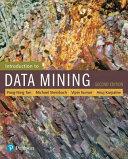
Introduction to Data Mining
Introduction to Data Mining, Second Edition, is intended for use in the Data Mining course. It is also suitable for individuals seeking an introduction to data mining. The text assumes only a modest statistics or mathematics background, and no database knowledge is needed. Introduction to Data Mining presents fundamental concepts and algorithms for those learning data mining for the first time. Each concept is explored thoroughly and supported with numerous examples. The text requires only a modest background in mathematics. Each major topic is organized into two chapters, beginning with basic concepts that provide necessary background for understanding each data mining technique, followed by more advanced concepts and algorithms. Teaching and Learning Experience This program will provide a better teaching and learning experience-for you and your students. It will help: Present Fundamental Concepts and Algorithms: Written for the beginner, this text provides both theoretical and practical coverage of all data mining topics. Support Learning: Instructor resources include solutions for exercises and a complete set of lecture slides.
- ISBN 13 : 9780133128901
- ISBN 10 : 0133128903
- Judul : Introduction to Data Mining
- Pengarang : Pang-Ning Tan, Michael Steinbach, Anuj Karpatne, Vipin Kumar, Michael Steinbach, Anuj Karpatne, Vipin Kumar,
- Kategori : Computers
- Penerbit : Addison-Wesley
- Bahasa : en
- Tahun : 2019
- Halaman : 839
- Google Book : http://books.google.co.id/books?id=_ZQ4MQEACAAJ&dq=intitle:Data+Mining&hl=&source=gbs_api
-
Ketersediaan :
This edition improves on the first iteration of the book, published over a decade ago, by addressing the significant changes in the industry as a result of advanced technology and data growth.


